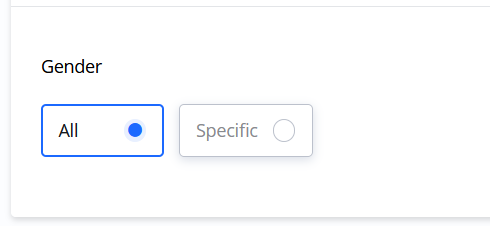Gender Targeting
Gender options for targeting are usually divided into Female and Male. Sometimes you can see Other as a gender option which can represent identified users who’s gender is either not identified or unknown.
Similarly like Age Targeting, in average only 10% of users of a website are identified with gender. It means by selecting specific gender, you risk limiting your potential audience by 90%. In short, fewer people see your ads.
Please be aware of the fact that when you select gender, even if you select all genders, your ads will only be shown to audiences with identified gender.

Important example about Gender Targeting
By selecting Male and/or Female you are limiting your audience to people with identified gender. This is important because even if you select both options, gender targeting can actually work against you.
An example:
100.000 people are potential viewers of a page.
10.000 of these are identified as Male.
15.000 are identified as Female.
75.000 are not gender identified.
If you want your ad to be shown only to men or women, select Male or Female.
Now, if you want your ad to be shown to everyone, this is where is gets a little tricky. If you select both options Specific: Male and Female, you are still limiting your reach to an audience with identified gender. In this example it means your ad will only reach 25.000. Your ad will not be shown to the 75.000 who are not gender identified.
If you wish to reach all 100.000, don’t select specific genders.
BOTTOM LINE![]() If you wish your ads to reach everyone, regardless gender, don’t use Gender Targeting.
If you wish your ads to reach everyone, regardless gender, don’t use Gender Targeting.